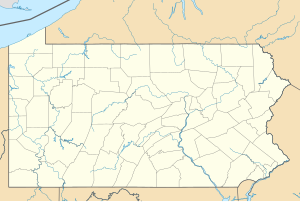Columbia – Wrightsville Bridge
Coordinates: 40 ° 1 ′ 44 ″ N , 76 ° 31 ′ 1 ″ W.
| Columbia – Wrightsville Bridge | ||
|---|---|---|
| Official name | Veterans Memorial Bridge | |
| use | Road bridge | |
| Convicted |
|
|
| Crossing of | Susquehanna River | |
| place | Columbia - Wrightsville | |
| construction | Reinforced concrete - arch bridge | |
| overall length | 2029 m | |
| width | 13.8 m | |
| Number of openings | 28 | |
| Longest span | 56.4 m | |
| start of building | 1929 | |
| completion | 1930 | |
| planner | James B. Long | |
| location | ||
|
|
||
The Columbia – Wrightsville Bridge , officially the Veterans Memorial Bridge since 1980 , runs the Pennsylvania Route 462 between Columbia and Wrightsville over the Susquehanna River in Pennsylvania , USA .
The bridge was in the 1984 List of Historic Civil Engineering Landmarks of the American Society of Civil Engineers added.
description
The bridge is 2029 m (6657 ft ) long including the two ramp bridges . It has a carriageway that is 12 m wide and offers an unusually large amount of space for two lanes, and a 1.80 m wide sidewalk on the downstream side. In Wrightsville, it crosses a local road and the riverbanks in front of the river; in Columbia, it crosses a road and the tracks of the Columbia and Port Deposit Branch .
About 50 m above the bridge are the buttress stumps of the Pennsylvania Railroad Bridge , which was demolished in 1963, and in just under 900 m you can see the Wrights Ferry Bridge , which leads US Route 30 over the river.
The Columbia – Wrightsville Bridge crosses the river with a 1624.6 m long series of 28 concrete arches with spans of 56.38 m (185 ft). The arches each have 3 reinforced concrete ribs on which the deck girder is elevated. The pillars, which protrude slightly over the parapets, provide a rhythmic structure of the long row.
The concrete arches are joined by fields of girder bridges of different lengths on both sides.
history
The bridge stands on one bank in Lancaster County and on the other bank in York County, which required special efforts in advance of its construction. Car traffic increased rapidly in the 1920s. The Lincoln Highway was the first coast-to-coast road. The Pennsylvania Railroad Bridge, which also served as a road bridge, could no longer handle the traffic. But the legal basis for a road bridge first had to be created. A 1925 referendum in both counties resulted in great support for the bridge plans. The approval of the US Congress for the bridge construction was obtained. Financing by the two counties on the basis of toll revenues was regulated. Complaints about the lack of constitutionality of the decisions made were resolved.
Ultimately, James B. Long was appointed chief engineer in August 1928. He submitted the plans and specifications for the bridge on February 18, 1929. The tender was published on March 9, 1929 and the bids were opened on April 9, 1929. On April 26, 1929, Wiley-Maxon Construction Co. was awarded the contract for $ 2,484,000. A bonus-malus scheme provided for $ 400 per day of early or late completion. The bridge was completed on September 29, 1930 - 140 days before the contractual deadline.
To build the bridge, two complete construction sites were set up on both banks, which worked around the clock in 11.5-hour shifts. A wooden trestle bridge was first built from each bank . The workers came to their place of work on it. Small construction site trams brought the required material on it at almost 30 km / h. Five gantry cranes with 25 m long booms drove high above the construction site tracks and took care of the distribution.
Steel arches served as falsework . In each of the first 5 bridge fields, a steel arch was set up for the outer concrete rib. After the ribs were concreted and set for 7 days, the steel arches were moved to the middle ribs, then to the third ribs. Then the steel arches were pulled on flat wagons to the next 5 bridge fields. The routine repeated use of these steel arches was probably the key to the rapid completion of the bridge.
The toll was ended in January 1943.
Web links
Individual evidence
- ↑ The information in this article is largely based on the report by Blythe Semmer: Columbia-Wrightsville Bridge . Historic American Engineering Record (HAER) No. PA-473

